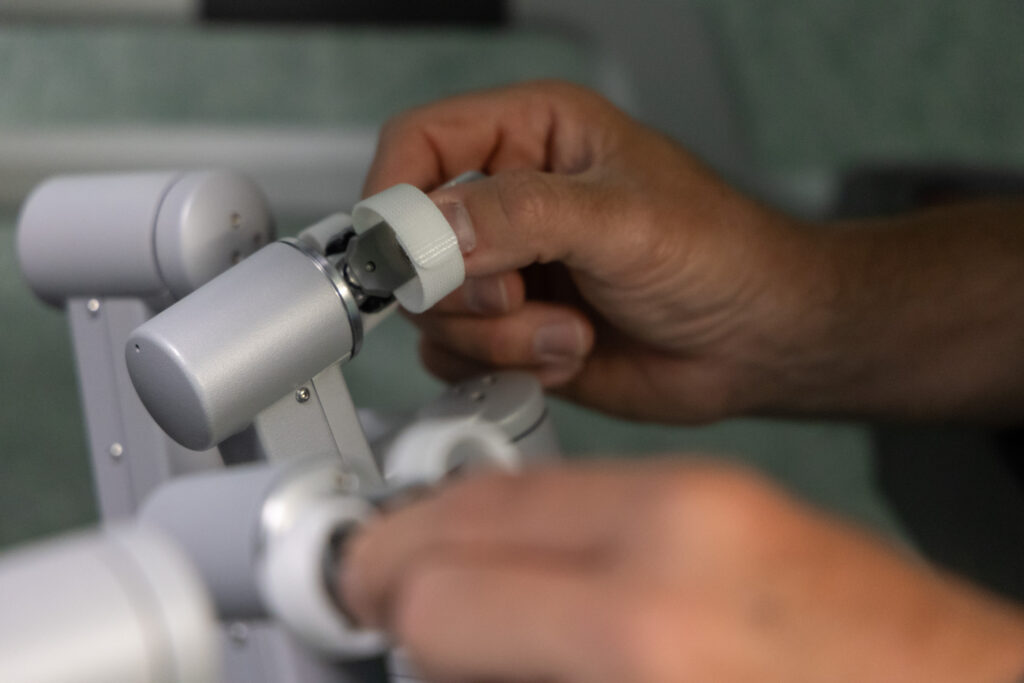Oncological Robotic Surgery
What is oncological robotic surgery?
Oncological robotic surgery is an advanced surgical technique that uses robotic systems to perform precise interventions in cancer patients. This procedure allows the surgeon to operate with greater control, flexibility, and precision thanks to robotic arms and high-definition three-dimensional images. It is especially useful in complex anatomical areas and in minimally invasive procedures.
What is this procedure for?
Oncological robotic surgery is primarily used in:
- Treatment of solid tumors: In interventions on organs such as the prostate, kidney, bladder, uterus, colon, rectum, lung, and head/neck.
- Tumor resection: For precise removal of tumor masses, preserving surrounding healthy tissues as much as possible.
- Personalized surgical planning: Helps design strategies adapted to the patient’s anatomy and condition.
- Reduction of complications: Serves to minimize the risk of bleeding, infections, and damage to vital structures.
- Improved quality of life: Used to facilitate faster and less painful recovery.
Benefits of high technology in oncological robotic surgery
The procedure uses a robotic system, such as the Da Vinci system, which consists of robotic arms controlled by the surgeon from a console. The arms are equipped with miniaturized surgical instruments and a camera that provides magnified three-dimensional images of the operated area. The surgeon manipulates the robotic arms with precise movements, eliminating tremors and improving the accuracy of the intervention.


What is the procedure like?
The procedure with cutting-edge oncological drugs involves:
-
Preparation:
In the initial consultation, both the oncologist and the surgeon will review your medical history and the results of previous tests, such as biopsies, imaging studies, and molecular analyses. In addition, complementary studies, such as a computed tomography (CT) scan or a magnetic resonance imaging (MRI), will be performed to plan the surgery. Fasting for several hours before the procedure is recommended. It is also important to inform your medical team about any medications you are taking, especially if they are anticoagulants.
-
During the test:
You will receive general anesthesia to ensure you are completely asleep during the procedure. The surgeon will make small incisions to insert the robotic arms and camera. From a console, they will control the robotic arms to precisely remove the tumor. Throughout the procedure, your vital signs will be monitored to ensure your safety. The duration of the surgery varies depending on the type of procedure and the complexity of the case, but generally lasts between 2 and 4 hours.
-
After the test:
You will be transferred to a recovery room, where you will be monitored for the first few hours after the procedure. You may experience mild discomfort at the incision site or a general feeling of tiredness. You will be advised to avoid intense physical activities for the first few weeks after surgery. The results will be evaluated by your oncologist and surgeon, who will explain the findings and the necessary follow-up.
Recommendations for the test
It is essential to inform your medical team if you are allergic to any medication or material used during the procedure. You must also follow all instructions before, during, and after the procedure to ensure your safety and the effectiveness of the treatment.
Does it have any risks?
Oncological robotic surgery is a safe procedure, but like any medical intervention, it may have minimal risks:
- Bleeding: At the incision site or within the operated area.
- Infection: Although rare, it can occur in the incision area.
- Injury to nearby structures: There is a low risk of damage to adjacent organs or tissues.
- Anesthesia-related risks: Dizziness, nausea, or allergic reactions.
For your test to proceed smoothly, we ask that you arrive in advance of the indicated time. This will allow us to carry out the necessary administrative and clinical preparation.
Before the test, we will provide you with the Informed Consent, a document with important information that you must read and sign.
If your appointment is for a Magnetic Resonance Imaging (MRI), it is crucial that you inform us about the presence of pacemakers, metallic objects, prostheses (including dental ones), tattoos, or medication infusion devices, such as insulin pumps.
These diagnostic tests are very safe, but as with any medical procedure, there is a minimal possibility of incidence.